July 1963 Popular Electronics
 Table of Contents Table of Contents
Wax nostalgic about and learn from the history of early electronics. See articles
from
Popular Electronics,
published October 1954 - April 1985. All copyrights are hereby acknowledged.
|
"The boy and his father
had just witnessed a demonstration of one of the most promising and fastest developing
technological devices ever conceived by man - the laser. In only three whirlwind
years, the laser - which gets its name from the initials of Light Amplification
by Stimulated Emission of Radiation - has moved out of the theory stage, out of
the laboratory curiosity category, and into a whole new, exciting world of applications."
That's the opening of an article in the July 1963 edition of Popular Electronics.
I remember when ruby lasers were the the rule rather than the exception for lasers.
Power levels were measured in units of "Gillettes" in reference in the number of
razor blades they could cut through. Next came chemical lasers with power levels
in the megawatts and now even gigawatts that can take out ICBM warheads as they
reenter the atmosphere and can fry orbiting satellites. At the same time the realm
of semiconductors and microcircuits was turning out devices on the opposite scale
for use in communications, inertial navigation, and boardroom presentation pointers.
This article is an extensive recounting in layman's terms the state of the art in
1963.
Laser Status Report - One development follows another
in rapid succession
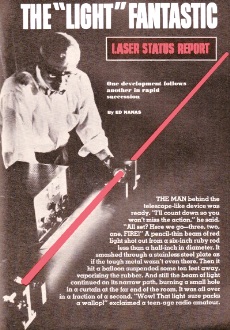
A c.w. gas laser recently demonstrated by Sylvania. An r.f. field
excites gas mixture to self-sustaining oscillation.
By Ed Nanas
The man behind the telescope-like device was ready. "I'll count down so you won't
miss the action," he said. "All set? Here we go - three, two, one, FIRE!" A pencil-thin
beam of red light shot out from a six-inch ruby rod less than a half-inch in diameter.
It smashed through a stainless steel plate as if the tough metal wasn't even there.
Then it hit a balloon suspended some ten feet away, vaporizing the rubber. And still
the beam of light continued on its narrow path, burning a small hole in a curtain
at the far end of the room. It was all over in a fraction of a second. "Wow! That
light sure packs a wallop!" exclaimed a teen-age radio amateur.
He was standing at the rear of the hall with his father, an electronics engineer.
"I've never seen anything like it!"
Until three years ago, nobody had seen anything like it!
The boy and his father had just witnessed a demonstration of one of the most
promising and fastest developing technological devices ever conceived by man - the
laser. In only three whirlwind years, the laser - which gets its name from the initials
of Light Amplification by Stimulated Emission of Radiation - has moved out of the
theory stage, out of the laboratory curiosity category, and into a whole new, exciting
world of applications.
The laser has the unique ability to generate and amplify light waves at specific
wavelengths just as radio waves are generated and amplified at specific wavelengths.
Light generated by a laser is known as coherent light because it is "pure," or predominantly
of one frequency. Making the sun seem like a hand-held flashlight by comparison,
the thin beams of coherent light, which have already vaporized steel and, in a recent
experiment, illuminated the moon, can be used to:
- Transmit a billion simultaneous telephone conversations on a single thread of
light one millimeter in diameter -without interference;
- Build laser radar systems, including portable range finders, having resolutions
more than 1000 times better than conventional narrow-beam radars;
- Perform micro-surgery - delicate eye surgery has already been demonstrated -
precise enough to allow cutting of a single human cell;
- Reach billions of miles into space with a beam powerful enough to guide a spaceship,
communicate with life on planets in other solar systems;
- Construct ultra-precise clocks, guidance systems, and laboratory instruments;
- Devise practical underwater communications and ranging systems using recently
developed techniques for generating green or blue coherent light;
- Build new battlefield weapons, including an anti-missile device and a form of
"death ray";
- Greatly speed up the functioning of complex computers by using lasers in conjunction
with fiber optic paths to transmit great masses of information within a computer
or from one machine to another;
- Investigate the possibility of transmitting electric power through space;
- Speed up chemical processes thousands of times, such as those that take place
during photosynthesis.
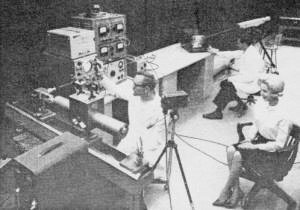
TV via laser is an accomplished fact. Image of the young lady
is relayed (in this experiment) to an optical modulator which impresses it on a
c.w. laser beam. The beam strikes a photocell in a telescope-like receiver (right,
rear) and is converted to the TV signal seen on monitor.
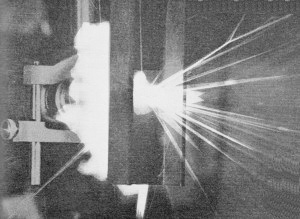
Highest power laser to date, the 350-joule Raytheon model may
soon be dwarfed by powers as high as 3000 joules. Intense beam of light is shown
blasting its way through a steel girder a quarter-inch thick.
Fantastic? Not at all; and the list is by no means complete. The laser is indeed
creating a revolution, and new discoveries relating to the generation and application
of coherent light are being announced almost daily. Let's take a closer look at
the phenomenon of laser light and the mechanisms used to generate it.
Coherent vs. Incoherent
Light waves coming from the sun or from incandescent or fluorescent lamps consist
of a broad band of frequencies all mixed together. In addition, light from these
sources can be considered as having been emitted from an infinite number of sources,
all of which have random phases and polarizations with respect to one another. We
call this kind of light incoherent.
A similar thing happens in the radio bands when lightning is discharged. A whole
host of frequencies are generated, and they can be heard as noise or static on a
radio receiver. As another example, incoherent water waves on the surface of a pond
can be created by throwing in a handful of pebbles; coherent waves by dropping in
a single large size rock.
Both a radio transmitter and a laser generate coherent radiation that is predominantly
of one specific frequency. The difference between the two is that the radiation
produced by the laser is very much higher in frequency (and, therefore, much shorter
in wavelength), so that it falls within the optical portion of the electromagnetic
spectrum.
The electromagnetic spectrum ranges from extremely low frequencies where wavelengths
(the distance between two specific crests or two troughs in a given wave) can be
measured in miles or meters, to frequencies far above the visible band where wavelengths
are measured in microns (one-thousandth of a millimeter) and angstrom units (one
ten-thousandth of a micron). In terms of cycles per second, light waves vibrate
at an extremely rapid rate - 1015 cps would be a rough figure.
t visible frequencies, radiation must be generated on an atomic level - as in
a laser. This is made possible by the fact that the atoms of certain materials,
when excited by large doses of energy, emit light at one frequency or group of frequencies.
Thus, a substance (ruby, for example) made up of atoms which can be excited, and
which will, at a certain point, emit coherent light, are used in lasers instead
of the electron tubes used at lower frequencies.
The Amazing Laser
The properties exhibited by laser beams are much more startling than the foregoing
explanation indicates. Like ordinary light, they can be focused and modulated, but
there the similarity ends. A laser beam, because of its extremely short wavelength
and because it is generated at the atomic level with all of the light energy in
phase, is a very narrow beam of extremely high energy. This energy, concentrated
at a single point, can burn through steel.
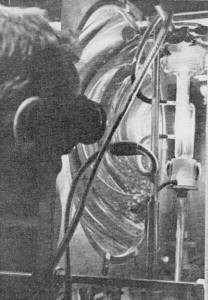
Continuous wave (c.w.) lasers have reached powers of 9 watts
and are expected to go higher in the near future. Many of these types use a dysprosium-doped
calcium fluoride crystal as does the RCA model below. The whole apparatus is enclosed
by two hemispherical mirrors which focus light on the crystal. The crystal itself
is obscured by the light source next to it.
The fact that a laser beam can be modulated is expected to be of great importance
in future applications. The reason is easy to understand. The transmission of a
voice by radio requires a band of frequencies several thousands of cycles wide.
The transmission of a television signal complete with sound takes up six million
cycles of the available spectrum. By and large, the radio portion of the spectrum
is now overcrowded, and the situation is expected to get progressively worse.
The use of optical frequencies for communications opens up great new vistas.
In the visible white-light portion of the spectrum alone, the number of frequencies
available is fantastic - 250 million megacycles! This figure represents thousands
of times more frequency space than in all the radio frequency bands combined. One
or two laser beams, relayed as microwaves are now, could carry all of the communications
traffic in America from coast to coast - telephone calls, television programs, computer
data, and facsimile!
Optical Powerhouses
The first successful pulsed optical maser (laser) generated a peak power of about
10 kilowatts for very short intervals. The newer lasers have now climbed much higher
- recently one was announced by the Korad Corporation with a peak of 500 megawatts
(500,000,000 watts) - all concentrated in one narrow beam of 7-nanosecond duration.
For the 500-megawatt pulse, it was calculated that the electric field in the focused
electromagnetic beam was on the order of 107 volts per centimeter. The
beam was observed
to cause ionization of the air in its focal path with a brilliant blue flash,
and spectacular damage was done to materials placed at the focal point. Since these
gigantic pulses of energy were for extremely short intervals, the total pulse energy
was only about 5 joules.
In only one year, the output energies of pulsed lasers have spiraled up from
1 or 2 joules (one watt for one second) to 350 joules. A thousand joules is just
around the corner and may be achieved by the time you read this. A glass laser with
a pulsed output of somewhere between 2000 and 3000 joules is under development by
American Optical Company, and may be announced as early as August, 1963. Theoretically,
there is no limit. Ten-thousand-joule-outputs are predicted within the next year.
What do all these figures mean? Just one joule - about the same amount of energy
you get from a flashlight bulb in several seconds of operation - is enough to vaporize
a hole through a 1/32-inch-thick sheet of steel if it is transmitted in a concentrated
burst of about a millisecond.
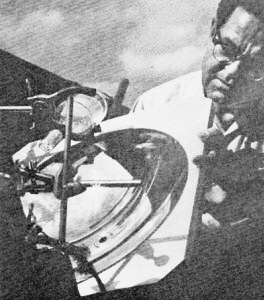
Sunlight pumping of a solid-state laser is a new development
which may soon make it possible to put sun-powered laser aboard satellites for communications,
tracking, and geodetic measurements. This device, designed by RCA, uses a 12" hemispherical
mirror to focus sun on calcium fluoride crystal rod.
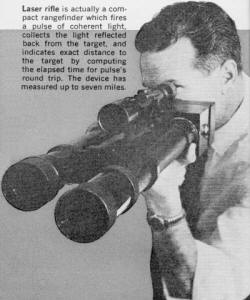
Laser rifle is actually a compact rangefinder which fires a pulse
of coherent light, collects the light reflected back from the target, and indicates
exact distance to the target by computing the elapsed time for pulse's round trip.
The device has measured up to seven miles.
A 10-joule ruby laser, which is fairly common today, operating at a wavelength
of 0.7 micron, has a power density at the center of the beam of about 1016
watts per square meter. The power density at the surface of the sun is less than
108 watts per square meter. Thus, this rather modest laser is capable
of producing a power density 100-million times that of the surface of the sun!
The Basic Laser
The essential ingredients of a laser are:
A Resonant Cavity
Usually formed by two reflecting surfaces, such as precisely parallel mirrors,
one slightly less opaque than the other;
An Active Medium
Positioned inside the cavity with its axis perpendicular to the reflecting surfaces.
It may be a (1) gas-a noble gas such as helium, mixed with neon, and contained in
a glass or a quartz tube; (2) crystal-a rod of high purity ruby, glass or a rare
earth material such as calcium tungstate; (3) liquid-an organic liquid, such as
benzene or pyradine; (4) semiconductor-the newest of the lasers, a gallium-arsenide
diode.
Pumping Power
Applied to the active medium to excite its atoms. It may consist of: (1) high-power
lamps - used with crystal lasers; (2) concentrated sunlight - also used with crystal
lasers; (3) electrical or radio frequency discharge - used with gas lasers; (4)
direct electric current - 10,000 to 20,000 amperes injected directly into the junction
of a diode laser.
The basic principles of laser light generation are similar to those of the microwave
maser. Atoms in the active medium can possess different amounts of energy. Ordinarily,
an atom will occupy the lowest of several energy levels, and is said to be in the
ground state. But when "pumping" power is applied, they get excited. That is, the
atoms absorb some of the photons (particles or "quanta" of light) from the power
source and jump to a higher energy level, like water being pumped into a tank atop
a standpipe.
At this higher energy level, usually two steps above the ground state, the atoms
begin to relax. They fall to an intermediate energy level, but still above the original
lowest level. This intermediate level is called the metastable condition, because
the atoms are more reluctant to leave it than they were to leave the higher level
to which they were originally excited. In order to make their departure they must
give up the light they absorbed. The important thing is that the light they give
up in dropping back to the ground state is of a specific wavelength.
Sooner or later, (within a few microseconds), the first atoms begin to drop from
the metastable level. They are put to work in the resonant cavity of the laser.
Without the reflecting surfaces, the light they emit would be mere fluorescence,
like that of a neon sign. But inside the resonant cavity of the laser, they are
bounced back and forth. With each pass parallel to the axis of the active material,
they stimulate other excited atoms in the metastable level to give off their absorbed
light much more quickly than they would ordinarily. The stimulated light moves in
the same direction as the light stimulates it. With each pass, the light gains more
energy in an effect akin to a chain reaction.
In only 200 microseconds or so, the released light waves, traveling in parallel
and in phase back and forth between the reflecting ends of the laser - you might
call it "feedback" - build up to an intensity great enough to escape through the
one end of the laser which is only partially opaque. This output beam of light has,
.most all of its intensity In a very narrow cone. All its waves are in step; of
the same phase and frequency, It is coherent light.

Basic configuration of a low-power c.w. gas laser. The reflecting
plates reflect back a large percentage of energy; result is a small, continuous
output.
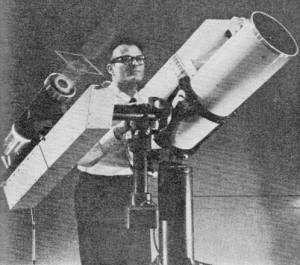
A "Colidar" (for Coherent Light Detecting and Ranging), produced
by Hughes Aircraft Co., operates on the same principle as the laser "rifle" opposite.
Research is underway on other laser ranging devices.
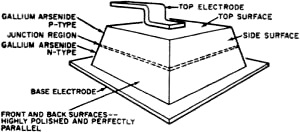
Gallium arsenide laser, greatly enlarged and shown in schematic
form, looks like this. Coherent light is emitted perpendicular to the front and
back surfaces and along the junction of device.
Continuous-Wave Lasers
A little over a year ago, the first crystal laser was made to operate continuously
(the high-power devices we have been discussing are pulsed) at Bell Laboratories
with power outputs of a few milliwatts. Gas lasers and semiconductor lasers also
have been made to operate continuously with comparative power outputs. As POPULAR
ELECTRONICS goes to press, however, a new 9-watt continuous-wave (c.w.) laser is
about to be introduced for use in research related to welding and other machine
tool uses.
A 45-watt c.w. laser may be another major development to be announced in 1963.
Both this unit, which is being researched at M.I.T.'s Lincoln Laboratory, and the
9-watt c.w. laser use dysprosium-doped calcium fluoride crystals rather than gases
or semiconductors.
Although c.w. lasers are somewhat puny in their power outputs compared to the
pulsed type, they have immense advantages as carriers for communications purposes.
At optical frequencies and with narrow beam angles concentrating all the radiated
energy into a small cone, a television channel could be established between the
earth and Saturn with only about 600 watts, while a voice channel to the most distant
planet, Pluto, could be maintained with as little as five watts.
Laser Status Report
Dr. Donald S. Bayley, of General Precision, Inc., one of some 400 organizations
conducting laser research, has said that an interstellar information channel carrying
one binary bit per second could be set up with the star Altair (16.5 light-years
away) with only 10 watts from a laser. Already, General Electric has designed a
burst communications system using a rapid laser pulse of great power (rather than
a continuous wave) to carry vast amounts of data.
Power Transmitters?
In the vacuum of space, attenuation is slight, governed primarily by the degree
of beam spread. Recently, Sperry Rand Corporation has been able to achieve the minimum
theoretical beam spread of a point source of light -0.005°, or 10-4 radians
- without the use of external lenses. Previously, the already narrow laser beams,
on the order of 0.05°, were further focused down by what amounts to an inverted
telescope.
The ultra-small beam spread of concentrated optical-frequency energy indicates
that it will be possible to transmit power over great distances with very little
loss; power for spaceships, for instance. It is now possible to construct optical
antennas, nothing more than a series of lenses, to transmit laser beams which would
lose only 1/30th of one percent in a 20-mile hop - far less than present-day transmission
lines. Thus, if you had a laser putting out one million watts, a hundred miles away
you would receive 997,500 watts: still quite a bit of power.
Laser Radar
One of the immediately attainable applications of the laser is in a radar-like
system for measuring distance and velocity, and for tracking. Several such systems
already have been built or are in the works, including those of Hughes, RCA, General
Electric, and Sperry. For example, the RCA tracking system, using a two-inch corner
reflector, is expected to achieve a range accuracy of six feet over 70 miles. The
Sperry system, using the Doppler effect, can measure the frequency shift of vehicles
traveling at 18,000 miles per hour, or as slowly as 0.2-inch per hour!
Such systems on the moon or in a satellite hold tremendous promise for guiding
spacecraft and rendezvousing in space. By 1965, laser radars are expected to provide
high-resolution maps of the moon and Mars, yielding new information about their
surfaces that will make landing a man a fairly safe procedure. A laser ranging and
telescope system will go into operation this year at Cloudcroft, N. M., to track
satellites such as the new Discoverer series; in that area of the country, the weather
is generally clear and lasers can be beamed into space from the ground.
Even the heavy-wheel gyroscope may be on its way out as a result of laser technology.
Sperry Gyroscope - the organization which invented the gyro - has come up with a
closed-circuit ring of lasers which can be used as an automatic device for guiding
ships, planes, missiles and space vehicles.
Brightest stars of recent research are semiconductor and liquid laser
devices.
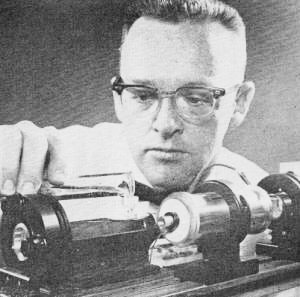
Liquid "frequency converter" that can change the frequency or
color of a laser beam.
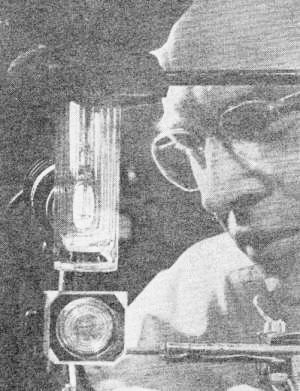
One of the first gallium arsenide lasers produced by G.E. (others
were made by I.B.M. and M.I.T.). It is suspended in liquid nitrogen to keep it cool
when large excitation currents are passed through it.
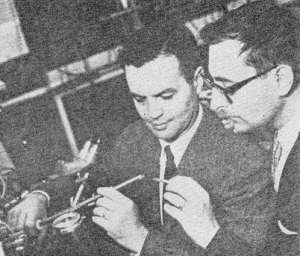
I.B.M scientists examine a brand-new semiconductor laser announced
very recently: an indium phosphide type.
New laser Types
One of the most important developments in the rapidly changing field of laser
technology came late last year when three organizations, I.B.M., General Electric,
and M.IT., announced almost simultaneously the development of a semiconductor laser.
The advantages of this type of laser-a gallium arsenide (GaAs) diode - are impressive
when compared to crystal and gas lasers. Semiconductor lasers approach efficiencies
of 100 percent as compared to a few percent for other types; they are excited directly
by electric current while other lasers require bulky optical pumping apparatus;
because they are excited by an electric current, they can be easily modulated by
simply varying the excitation current.
Gallium arsenide diodes (research models are already available as relatively
low-cost, off-the-shelf items) consist of a layer of p-type gallium arsenide and
a layer of n-type gallium arsenide. When electrons in an intense electric current,
about 20,000 amperes per square centimeter, are applied to the device, it emits
coherent or incoherent light, depending upon the diode type, from the junction between
the two layers of gallium arsenide.
Current research is concerned with improving the efficiency of semiconductor
lasers, modulating them, and, in a new twist, using them as "pumps" to improve greatly
the efficiency of other types of lasers.
Developed in a number of forms are lasers which use rare earth chelates - molecules
which completely enclose each atom of a rare earth element such as europium. Chelates,
combined with plastic, a liquid or other medium, can be pumped to produce laser
action.
One of the most important new laser techniques is a method for generating light
of different frequencies or colors from a single laser beam. By beaming coherent
light through a liquid such as nitrogen, light of other frequencies is obtained.
Laser frequencies can also be altered by heterodyning two beams by mixing them within
a crystal. These developments make it possible to convert intense laser beams to
any frequency; green, blue, or from far infrared to near ultraviolet regions.
Also within the year we have seen lasers operating at room temperatures rather
than having to be immersed in expensive cryogenic environments to keep them cool.
Lasers pumped by the sun, by cathode-ray fluorescence, and by exploding wires, as
well as by directly applied electric current, have come into being in the past twelve
months. Raytheon and M.IT. have bounced a laser beam off the moon. Whereas early
last year you had to build your own laser if you wanted one - an expensive and delicate
process even for the most advanced electronics engineer-you can now buy a wide variety
of laser types.
The Modulation Problem
While predictions on the future usefulness of laser beams in communications are
highly optimistic, much work remains to be done on developing practical methods
of modulation. Communications - including television signals - have already been
transmitted by laser in laboratory setups, but thus far, only a small fraction of
the fantastically large available bandwidth in a laser beam has been utilized.
The various approaches to modulation can be divided into two groups: internal
modulation applied while the coherent light is being generated, and external modulation
applied to the light beam after it leaves the laser. As we noted earlier, the gallium
arsenide laser is relatively easy to modulate using an internal technique. The excitation
current can be simply varied to produce modulation.
Another method of internal modulation, used with other types of lasers, involves
changing the Q of the laser cavity with an electro-optical shutter between the laser
material and a reflecting end plate of the cavity. This introduces a variable loss
which causes large changes in the level of operating power akin to amplitude modulation.
A third approach is Stark-effect modulation, achieved by sending a strong transverse
electric field into the laser material. This field causes line-splitting and frequency
modulation of the output. A similar technique, using a magnetic field, has also
been used. It is called Zeeman-effect modulation.
External modulation of the laser output can be accomplished using the Pockels
effect, in which the beam is passed through a piezoelectric crystal which can be
"strained" by an electrical field. Other external modulation approaches include
the Kerr effect (plane-polarization), varying the pumping power, and mechanical
means, such as the use of shutters, graings, lenses, reflectors and ultrasonics.
For demodulation, the radiation must be converted to electrical energy in most
cases. New phototubes, photomultiplier detectors, and photodiodes have been developed
for this purpose within the last six months. With coherent radiation, the same techniques
will work with light beams that will work with microwaves, so it boils down to a
difference in detail, not principle. Superheterodyne techniques can be used to convert
the light into lower frequency signals, such as microwaves; microwave detection
equipment can then be employed. "Heterodyning" is accomplished by "beating" one
laser beam with another. The result is a frequency equal to the difference between
the two falling in the microwave region.

Continuous wave crystal lasers use configurations somewhat like
this Bell telephone design. The neodymium crystal is at one focus of a elliptical
cavity, and the mercury lamp at the other to concentrate pumping light.
Lasers, Present and Future
As indicated earlier, it isn't only the communications people who are taking
a close look at the laser. At Columbia-Presbyterian Medical Center in New York,
ophthalmologists already have used a ruby laser beam to coagulate a human eye retina
to prevent it from becoming detached. Such an operation can be com-pleted in less
than 0.001 second, eliminating the possibility of damage due to eye motion during
the exposure.
The machining and welding potential of the laser has already been demonstrated
in certain applications. At G.E., the surfaces of industrial diamonds have been
vaporized the instant the high-energy light beam strikes them. Production lines
are now being set up to use the laser beam in cutting "components" to size for use
in microcircuits, and to weld leads to semiconductors.
 The laser also holds the potential of becoming
the ultimate anti-missile weapon. One proposal is to use high-power beams of several
lasers focused on the enemy missile with sufficient energy to vaporize it. This
would be a "clean" weapon compared to anti-missile rockets with nuclear warheads
and their attendant radioactive fall-out. The laser also holds the potential of becoming
the ultimate anti-missile weapon. One proposal is to use high-power beams of several
lasers focused on the enemy missile with sufficient energy to vaporize it. This
would be a "clean" weapon compared to anti-missile rockets with nuclear warheads
and their attendant radioactive fall-out.
A new laser scheme which theoretically could generate a billion joules or more
is under development now. It involves the separation and sorting of hydrogen spins,
the physics of which are too complex to go into in this article. Such a powerful
laser could transmit its beam through the atmosphere and earth cloud cover and still
deliver enough power at the impact point to vaporize a missile.
Power requirements could be sharply reduced, however, by orbiting an anti-missile
laser above the atmosphere. Laser light could also be used as a spotlight from space
for photography at long distances.
The laser is less than three years old, yet we have already come a long way.
The experts say that this is one field in which we are well ahead of the Russians.
To understand the laser is to understand an important facet of the future of communications,
medicine, machining for industry, and the practical equivalent of the legendary
death ray.
Whatever use the laser is put to, its impact on mankind will be great-comparable,
perhaps, to the discovery of atomic energy. When and how will the impact be felt?
Only time will tell.
Posted April 21, 2023
(updated from original post
on 1/16/2013)
|






















 The laser also holds the potential of becoming
the ultimate anti-missile weapon. One proposal is to use high-power beams of several
lasers focused on the enemy missile with sufficient energy to vaporize it. This
would be a "clean" weapon compared to anti-missile rockets with nuclear warheads
and their attendant radioactive fall-out.
The laser also holds the potential of becoming
the ultimate anti-missile weapon. One proposal is to use high-power beams of several
lasers focused on the enemy missile with sufficient energy to vaporize it. This
would be a "clean" weapon compared to anti-missile rockets with nuclear warheads
and their attendant radioactive fall-out. 